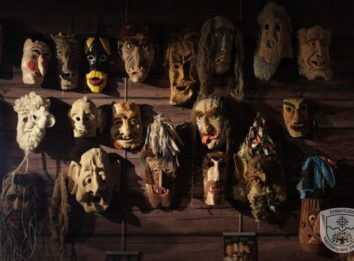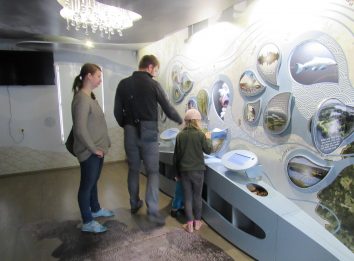Expositions
GUIDED TOURS ARE TAKEN ONLY BY ORDERING SERVICES IN ADVANCE, NOT FOR GROUPS OF LESS THAN 10 PEOPLE.
In order to improve the quality of our services, please fill this anonymous form https://forms.gle/1oVLtVttSm8R3Wu36. Leave your suggestions and comments by clicking the link above.
New, attractive, interesting, modern expositions, new experience and the spirit of Samogitia.
Manor of Plateliai has opened its doors to visitors. In the former estate Stable is founded Shrove Tuesday Museum, in the Barn – a modern historical-ethnographic, nature exposition, exhibition hall. A colorful exhibition of nature offers access to interactive wildlife of Park. Ethnographic exhibition highlights the ancient Plateliai – crafts, entertainments, courtiers and ordinary people’s lives. Visiting the Shrove Tuesday Museum at any time of year one can feel like in a whirl of Samogitian winter games. We invite you to visit.
Address: Didžioji street 22, Plateliai, Plungė dstr.
Coordinates: 363800, 6213735 (LKS); 56.038255, 21.814255 (WGS); 56° 2′ 17.72″, 21° 48′ 51.32″ (WGS).
- S. Sidabro n.
Working hours :
Tuesday – Friday 10:00-17:00
Saturday 10:00-17:00
Lunch time 12.00 – 13.00
Sunday 10.00 – 15.00
Day off – Monday
Expositions will be closed on the All Saints’ Days (1, 2 November), Christmas Eve (24 December), Christmas (25-26 December), New Year (1 January) and Easter (16-17 April).
Attention: Visitors can’t visit the museum if less than half an hour left till the lunch time or the end of the work.
Entrance fee:
For adults – 4,00 €;
For children, students, pensioners, disabled people – 2,00 €;
Guide service (in foreign language) – 35,00 €;
Cold War Museum is located in the former Soviet Union`s complex of ballistic missile silo launch. Since 1963 up to 1978, there had been deployed four medium- range ballistic missiles SS-4, armed with 2- megaton power thermonuclear warheads. These missiles, together with the nearby terrestrial platforms of analogue missile launching, had created a common Soviet nuclear armament group in Lithuania, which was able to destroy all the Europe.
The Rules of the Visitors of the Cold War Exposition
Adress: Šilinė street 4, Plokščiai, Plungė dstr.
Cold War exposition (visitor centre) coordinates: 369504, 6212682 (LKS); 56.030391, 21.906232 (WGS); 56° 1′ 49.41″, 21° 54′ 22.44″ (WGS).
Tel. +370 677 86 574, +370 616 15710 (need to book in advance an excursion for groups more than 20 people).
E- mail: ilona.urnikiene@zemaitijosnp.lt
Address: Šilinė street 4, Plokščiai, Plungė dstr.
Coordinates 369506, 6212885 (LKS) or 21.906174, 56.032209 (WGS).
Tel. +370 616 15710, +370 677 86 574.
E- mail: ilona.urnikiene@zemaitijosnp.lt
Working hours
During the tourist season (May – September) – Mondays – Sundays, 10:00 a.m. – 7:00 p.m.;
During the off-season (October, April) – Mondays – Sundays, 10:00 a.m. – 5:00 p.m.;
During the off-season (November – March) – Tuesdays – Sundays, 10:00 a.m. – 5:00 p.m.
Days off: Mondays, in the period from November 1 until March 31
Guided tours in English can be booked in advance for groups of at least 10 people.
The museum will be closed on the All Saints’ Days (1, 2 November), Christmas Eve (24 December), Christmas (25-26 December), New Year (1 January), Easter (on the first and second day).
For adults – 10,00 € ( the tickets price 1st January to 30th of June) ( 1st September to 31 of December).
For adults – 12,00 € (the tickets price 1st July to 31st of August);
For children, students, pensioners, disabled people – 5,00 € (the tickets price 1st September to 30th of June);
For children, students, pensioners, disabled people – 6,00 € (the tickets price 1st July to 31st of August);
Audio guide service – 4 €
3d tour of The Cold War Exposition
First of all pay attention to the restored piece of multi – stage electronic security system. During the operation time of base the whole vast area was protected by armed soldiers, electric fences and alarms. You can see the Cold War views at the Info – centre which is on the right side of central entrance.
When you will enter the silo launch complex area, pay attention to the four underground silo shells as well as to the technological unit – bunker for all the necessary equipment and the control elements, which is inside of it. Hundred tons silo shields could withstand a nuclear bomb explosion.
Let`s come down to the bunker. At the end of the corridor you will find yourself next to the central control apparatus room. Previously there were four missile control panels and the commands for the missile launch were to be given here. Historical view of this room is rebuilt on the basis of archival footage. You will see in the video- terminal that was formerly showed only on the top – ranking leaders of the USSR. Now this room is equipped with a historical exposition, telling about beginning of the Cold War and of its evolution: from the first disagreement between the allies of the Word War II to the nuclear arming race. Historical exhibits, photographs and video materials will help to understand better this military conflict and to realize how close the nuclear abyss was, though the strength for refusal of mutual self – destruction was found: the course of disarmament is shown at the end of the exposition in the hall.
The armament exhibition is located in the next hall, in the former control apparatus room of fuel components and silo shells. Layouts represent the internal structure of the silo launch complex and missile silo. All devices and units here are newly made in compliance with the original hardware, most of which did not remain in the complex.
The next hall is dedicated to the evolution of missile technology. The combat missile components and equipment from the Cold War period and the only exact model of missile SS – 4 are exhibited here. At the end of the hall there is a restored cabinet of a bunker`s commander. You will see the rigorous colonel which is authorized by this country to “keep a finger” on the “nuclear button” behind the glass.
Let`s acquaint with the restored equipment of communication node and the crew when you will go further down. The political propaganda exposition installed here: during the Cold War years this counter measure was actively used in the Soviet Union and NATO countries. In the ground floor of the bunker you will find the complex hall of electric power plant with the remains of powerful generator, and in the former premise of the electricity distribution you will get acquainted with the information on the Soviet leadership`s efforts to prepare the society of country for possible nuclear conflict shown as a civil defence exposition.
Continue walking along the narrow corridor toward the silo. Previously, it was even narrower because all the walls were filled with the conduits of missile fuel components, electrical cables and other communications. Once you appear in the silo you will see the place where the combat missile was kept for almost two decades. Almost thirty meters depth silo is a complex engineering building, filled with various facilities and communications.
Adress: Zemaitija National park visitor’s center, Didžioji street 8, Plateliai, Plungė dstr.
Tel.: +370 448 49231;
E-mail: info@zemaitijosnp.lt
Ticket price: 1,00€/person
Guided tour in foreign language cost 17,50 €
Working hours :
Tuesday – Friday 09:00-18:00 (Lunch time 12.00 – 12.45)
Saturday 10:00-15:00
Days off – Sunday, Monday.
After arriving at Plateliai, notice the dark brown wooden house with a sloping Samogitian roof in the center of the town. Do not be fooled by the outside of the hundred-year old building – inside it is the national park’s visitor center with a modern exhibition, which includes touch screens, sound effects, natural games and descriptions of various routes and points of interest.
Inside, your attention will be grabbed by the three-dimensional model of Plateliai Lake, which shows the impressive differences in the lake’s depth, which are hard to notice when you are at the lake. By browsing the droplet-shaped windows, you will get to know the sights of the lake and its surroundings as well as where the names of the islands originate from. After coming up to the second floor, look up and listen – what do you hear? You are met by the inhabitants of Zemaitija forests and meadows. Have you seen the footprint of a hedgehog? Where are butterflies’ ears? Which birds are the biggest sleepers? Here you will find the answers to these and other questions. In the farthest corner of the room, visit the beaver’s habitat. Listen to the night sounds of forests and try to guess the names of the plants stored in the colored flasks by smelling them.
If you are still having a difficult time deciding which way to go, ask the employees of the visitor center for advice. Examine the map of Zemaitija National Park hanging in front of the entrance, which illustrates various sightseeing trails as well as the most important heritage objects, museums and viewpoints. Grab some leaflets with descriptions of locations and objects and prepare for unforgettable experiences in nature!
Part of the exposition on the 1st floor is accessible for people with physical disabilities, a ramp for access to the building, a toilet adapted for people with disabilities.



































